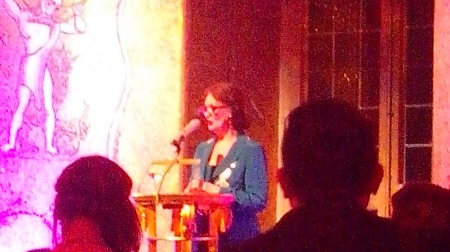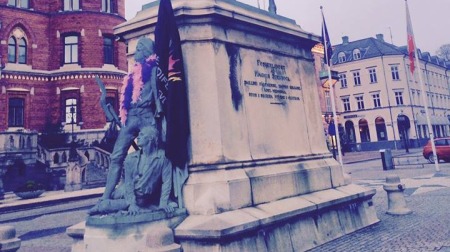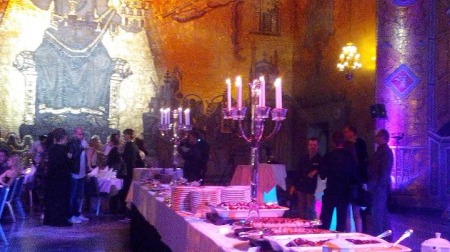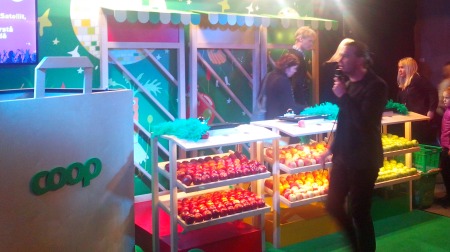Working as part of the press team at Eurovision across the different National Finals, it is always a pleasure when countries are able to offer an extra chance to mingle with the acts and enjoy the atmosphere: a bonus to the fun when a little something happens alongside the main show.
It is far from a little something when it comes to Melodifestivalen. For the six weeks of Sweden’s biggest TV show the parties and mingles are as much of a highlight as the competition on stage. It’s no wonder Melodifestivalen gets such a reputation as the biggest and flashiest of all the National Finals. No other country offers anything to this excess, if anything at all. We sent Ben Robertson to investigate the glitz and glamour surrounding Sweden’s biggest TV show.
All journalists working at the Final of Melodifestivalen are invited to the formal Welcome Party in Stockholm’s City Hall (famous amongst other things for the Dinner for the Nobel Prizes) which is just one of the regular things that happens each Melodifestivalen week. For a month and a half this happens across Sweden with each local council putting on a huge show to welcome guests from across the country to their town. For each and every host city this is an important chance for them to shine and show off what they can offer. As well as journalists, artists, sponsors and members of the SVT team the Welcome Party also brings in key dignitaries from the host town, in this case letting the President of the City Council, Eva-Louise Erlandsson Slorach open the evening.

The President of Stockholm’s City Council ended her speech with saying that ‘we would like to host the big Eurovision’
After talking on stage I asked the Social Democratic member of Stockholms Stad about why running an event like this was so important for Stockholm.
I think it is very important because Stockholm is a musicians’ town. We are interested that Stockholm will be a musical city, the culture here is very important for a city like Stockholm. It’s more than a TV show, the Melodifestivalen is important for the musicians taking part but for Stockholm it is important that young people are interested in culture and music.
Certainly the prestige of holding the Welcome Party in such a well known and iconic venue is going to heighten the interest of this event for young people. This is not just Stockholm throwing on a kick-off to the final festivities, every town big or small across Sweden pulls out the top drawer effort to welcome all. Academic research into this suggests it is not so much about competition between towns for superiority, but more about putting on a show and proving that the town is capable of hosting such big events. In this sense it is easy to link hosting a part of Melodifestivalen to hosting a Eurovision Song Contest. The level may be localised rather than national, but the importance to put on a good show and prove your ability as a successful town is just as valid.
It is important for SVT as well that this relationship is symbiotic and both are able to benefit from each other as Christer Björkman, Show Producer for Melodifestivalen, explained to me.
The engagement of the cities is very important because when we come to a city we want to be warmly welcomed, and we actually make an impression in the city for its inhabitants. Then we know that the city and its people will love the competition and then spreads into the show and the media. That’s really important.

Helsingborg decorated the entire town to celebrate the arrival of Melodifestiavlen (Photo: Helsingborg Tourism Board)
To put it bluntly, for all concerned being a part of the six-week circus is a big deal. The more a town can become a part of that big deal, the better impact it has on the competition’s status but also the local residents and businesses.
Fitting In As The Fly-On-The-Wall
This is of course an important chance for informal mingling before the serious business of rehearsals the following day. As artists enter they are bombarded with a long trail of cameras, not massively smaller than you would get on Eurovision’s Red Carpet. After that scrum is the stream of people from the official and unofficial press to say how wonderful all the dresses and outfits are for each of the artists before mingling upstairs with a few free drinks (a rarity in Sweden) and nibbles. There is a buffet dinner afterwards featuring the Swedish staples all accompanied with live piano playing in this most picturesque of settings. Fredrik Kempe and Thomas G:Son were happily digging into the dessert table as Mariette’s gang made the point of raucously toasting each other.
One may fear about local taxpayers cash being flashed out for these celebrities to have a good time, however the towns in question get a good deal out of exposure. Northern town Sundsvall for example paid 550,000 Swedish Kroner (around £50,000) as part of having a marketing package associated with the show, but many others towns around Sweden have not had to cough up a penny to bring the glitz and glamour home. This is not given to SVT for the TV spectacle though; the direct running of sponsorships and extra activities are co-ordinated by event management company Live Nation.
I met up with Live Nation’s Project Director Anders Leijon and Project Manager Jamie Perry to discuss the role their organisation has in creating the Melodifestivalen bubble.
Keeping The Tour Going Week On Week
Their roles involves being in charge of the sponsorship contracts and agreements as well co-ordinating the details for all of the afterparties and VIP’s. The sponsorship part of their role is pivotal to ensuring the tour can keep continuing. Christer Björkman was frank enough to say that we would be ‘back to Studio 1’ if for whatever reason the sponsorship coppers were withdrawn. We start off talking about Jamie and Anders about how they attract the required sponsorship to Melodifestivalen.
Firstly the history of the format in Sweden is strong, being a regular annual TV show event and of course the break that ABBA had previously. The sponsors are not able to actually show adverts in the TV broadcast, but they are active in and around the different arenas.
The feeling you get of sponsors in the arena for the different Melodifestivalen shows is something that even Eurovision hasn’t replicated. Walking around the concourse of Friends Arena you have supermarkets distributing free fruit, electrical companies playing bingo style games and newspapers giving away what I can attest have been very useful canvas bags. Some of Sweden’s biggest companies are here to showcase themselves to the stream of audience members which in total will come to over 150,000 people for each Melodifestivalen season. Anders continued.
Some of our visitors get to walk around the foyer taking part in activities, and if you are watching the TV show you miss out on all these other things. These things are a bonus and add value to the event and are important. We make research on all our visitors to the finals to know what they think of the variety of events and activites.
If you go to the live event it is more fun compared to watching it on TV, and that feeling is hard to describe. We see how people take the time to dress up. They spend a lot of time and they come to the arena because there is a certain culture when you are there. People become emotionally involved in the show.
Sponsorship of Melodifestivalen is more than just showing a trailer before the show or attaching your logo on the publicity. Being a sponsor means that you are becoming a part of the culture as well, you are offering something that shares the excitement and buzz before the show starts, and produce things that last longer in the memory for those visitors as well. To make Melodifestivalen what it is today sponsorship is undoubtedly essential, and not just from a purely financial point of view.
The Most Anticipated Party In All Of Stockholm
The Welcome Party was of course a flash affair, but it was all a very civilised event truth be told as you would expect with rehearsals the following day. The official Afterparty however is infamous for extravagant excesses, with photographs splashing over the tabloids as liberally as the winners’ champagne flows. This night can be continuing well until after the mid-March sun rises above the horizon and the plethora of stories and gossip will filter throughout Swedish society over the coming days (those wanting the who-was-talking-to-who dirty details should check on Aftonbladet’s Schlagerblogg the morning after). Because of this fallout, as press we are instructed that video cameras are not to be used after 00:30 on Sunday morning. Make of that what you will.
The organisation of this is also part of Live Nation’s remit as well, with Anders boasting of the ‘really huge budget’ they have to keep the party going. However unlike a Eurovision where a significant chunk of finances comes from the host city for entertainment expenditure, Melodifestivalen must be self reliant on ticket sales and sponsors to make these events a possibility.
I ask Anders what I will expect from the evening.
The Afterparty starts slowly with a mingle, and then it bursts into life about 23:30 when the winner arrives at the artist entrance. When the winner is coming it is insane. It is one of the most popular, famous and anticipated parties in Stockholm during the year. We have loads of cameras, big screens and a stage where all the artists get to perform on. We couldn’t do this fantastic party of a show without having the Afterparty as well as a part of it.
The real beauty of Melodifestivalen though is how it is able to cross over so many generational boundaries. For our youngest demographic the adaptations are as simple as having children’s TV presenters running the warm up activities and giving away memorabilia before the hosts appear to start the show. Anders was keen to tell me about his VIP Kids section for the final tomorrow with free ice cream and a chance to meet one of the artists who will pop up after the performances.
What Melodifestivalen does with all of these extra details is feed fantastic stories and hype to every generation of Swedes. It creates a bubble that people want to go and chatter about on Monday morning at school or at the coffee machine. Everybody visiting spreads the tales of joy and wonder and gives it their own unique buzz. It’s easy to see how the numbers of people interested in the show spread from the hundreds of thousands to millions each and every Saturday night.

Children’s TV Show host Nassim Al Fakir joins the crowd of children before the Jury Final (Photo: Alison Wren)
Brand Melodifestivalen Is More Than A Two Hour Show
Over 150,000 people pass through the doors on the arena tour of Melodifestivalen and those numbers take away with them something special. Attending a Melodifestivalen show throws you into a colourful world of wonder which even the superb TV production can not muster up. The little things such as free chocolates, pom poms and souvenir T-shirts are lapped up by visitors and these stories are shared with their immediate friends and families, turning Melodifestivalen into the multi-million viewed event each week of dark February. It’s presence in mainstream culture offers a little warmth to an otherwise frosty Swedish landscape. As Anders said at the end of our interview, ‘the day Melodifestivalen starts gives many Swedes the same feeling as if Christmas Day has arrived.’ There is no other National Final anywhere close to being this highly anticipated.
It’s important to make sure that anticipation crosses over boundaries, and this is not just something dictated by the variety of songs SVT choose to keep in the competition. This is also considered by those behind the scenes on all the other activities. Local dignitaries and decision makers are actively encouraged to co-operate while small children get dedicated coverage and TV shows. Casual viewers catch the fallout of fashion disasters and party excesses through the morning papers and the drip-feed of official information keeps the super-fans on constant tenterhooks. Brand Melodifestivalen is more than a TV show in a way light-years beyond the wildest dreams of any other Eurovision broadcasters.











